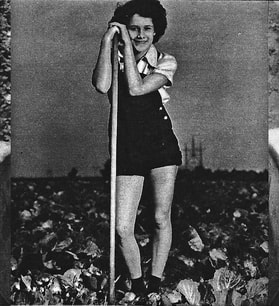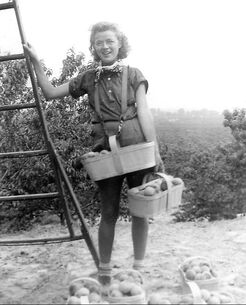About
During the First and Second World War, Canada made significant contributions to the Allied war effort. In the First World War, approximately 650,000 Canadians served in the Armed Services (from a population of 8 million), and more than 1 million men and women served in the Second World War. The Dominion of Canada also increased its production of food, munitions, and supplies to support the war effort, turning the country into an industrial giant. However, this meant that in both World Wars, rural populations suffered as men and women were pulled into the Armed Services or well-paying industrial sectors in urban areas. While the nation’s demand for agricultural products increased significantly, farmers across Canada began to wonder who would help them with this great task.
Rather than following Britain’s lead in establishing a nationally-operated Women’s Land Army in order to organize, recruit, and transport thousands of women across the country to fill positions as agricultural labourers, Canada’s federal government left the organization of farm labourers in the hands of each province, as, under the British North America Act, agriculture was typically regulated provincially rather than federally.
During the First World War, Ontario was the only province to organize a Women's Land Army, operational between 1917-1919. This put them in good stead when Canada entered into the Second World War and farm labour shortages emerged once again. The Ontario Farm Service Force re-implemented their WLA in 1941, and, it was so successful that it remained operational until 1952.
Using Ontario's program as a template, British Columbia organized their own Provincial Women's Land Army during the Second World War, recruiting women from within the Province, but also reaching out to women from Alberta and Saskatchewan as well. Their program was operation between 1943-1948.
While we acknowledge that other provinces also strived to maximize food production in agricultural areas with a depleted labour force, only Ontario and British Columbia implemented an official Provincial Women's Land Army under the auspices of a Dominion-Provincial Emergency Farm Labour Agreement. To learn more about how these two provinces ran their programs, and the girls who took part in it, click through our pages on Ontario and British Columbia.
Rather than following Britain’s lead in establishing a nationally-operated Women’s Land Army in order to organize, recruit, and transport thousands of women across the country to fill positions as agricultural labourers, Canada’s federal government left the organization of farm labourers in the hands of each province, as, under the British North America Act, agriculture was typically regulated provincially rather than federally.
During the First World War, Ontario was the only province to organize a Women's Land Army, operational between 1917-1919. This put them in good stead when Canada entered into the Second World War and farm labour shortages emerged once again. The Ontario Farm Service Force re-implemented their WLA in 1941, and, it was so successful that it remained operational until 1952.
Using Ontario's program as a template, British Columbia organized their own Provincial Women's Land Army during the Second World War, recruiting women from within the Province, but also reaching out to women from Alberta and Saskatchewan as well. Their program was operation between 1943-1948.
While we acknowledge that other provinces also strived to maximize food production in agricultural areas with a depleted labour force, only Ontario and British Columbia implemented an official Provincial Women's Land Army under the auspices of a Dominion-Provincial Emergency Farm Labour Agreement. To learn more about how these two provinces ran their programs, and the girls who took part in it, click through our pages on Ontario and British Columbia.



